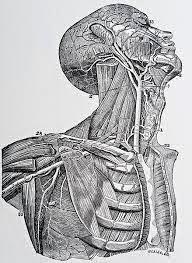This
week we looked at medicine, technology, and art. Being a physiological science major, this
topic particularly peaked my interest.
The
human body has always been a major part of art, particularly during the
Renaissance period when people began to experiment with human dissection (Bambach 2000). Then in 1858, Henry
Gray published Anatomy, and the book
has been commonplace on the shelves of artists and physicians alike.
An illustration from Gray’s Anatomy.
https://www.rcseng.ac.uk/museums/hunterian/exhibitions/archive/150-years-of-gray2019s-anatomy
New
technologies in plastic surgery following World War One resulted in an increase
in popularity. Society has become
fascinated by it as expressed by the popularity of the television drama Nip/Tuck and the reality series Dr. 90210. In many ways, the plastic surgeons themselves
are exhibiting the connection between medicine and art by trying to create
something beautiful through their work as a medical professional. Additionally, the artist French Orlan has
plastic surgeries performed on her for her artwork. She has undergone operations in order to “to transform
herself into a new being, modeled on Venus, Diana, Europa, Psyche and Mona Lisa”
(Pescarmona 2003).
The artist Orlan.
http://www.ienhance.com/articles/the-weird-science-of-plastic-surgery-art-introducing-artist-orlan
Eduardo
Kac is a Brazilian artist interested in many disciplines of bio art. One of his notable works is the GFP Bunny, which was the successful
breeding of a rabbit with green fluorescent protein giving the animal a green
glow (Plohman 2000). Like Orlan before him, the science is part of the artwork itself. He hoped the art of his rabbit would force people to become aware of biotechnology.
GFP Bunny.
www.ekac.org/gfpbunny.html
References:
"About Dr.
Rey." Dr. Robert Rey. Web. 23 Apr. 2015.
<http://www.drrobertrey.com/pages/about.html>.
Bambach, Carmen.
"Anatomy in the Renaissance". In Heilbrunn Timeline of Art
History. New York: The Metropolitan Museum of Art, 2000.
http://www.metmuseum.org/toah/hd/anat/hd_anat.htm
"BIO ART." KAC. Web.
23 Apr. 2015. <http://www.ekac.org/transgenicindex.html>.
Pescarmona, Denee. "Who Is
Orlan?" UCSB English. 1 Jan. 2003. Web. 24 Apr. 2015.
<http://oldsite.english.ucsb.edu/faculty/ecook/courses/eng114em/whoisorlan.htm>.
Plohman, Angela.
"Eduardo Kac." Daniel Langlois Foundation. 1 Jan. 2000.
Web. 23 Apr. 2015.
<http://www.fondation-langlois.org/html/e/page.php?NumPage=279>.



Hi, Brooke! I enjoyed reading your post! It was interesting that you connected the art with anatomy, plastic surgery and biotechnology! You made me understand that "The human body has always been a major part of art." I'm impressed we can express "beautiful" in between the human body and medical world. Even though I never thought that medical world is part of the arts, now I realize the art must be essential for our society!
ReplyDeleteThank you for good post!
Shizuka